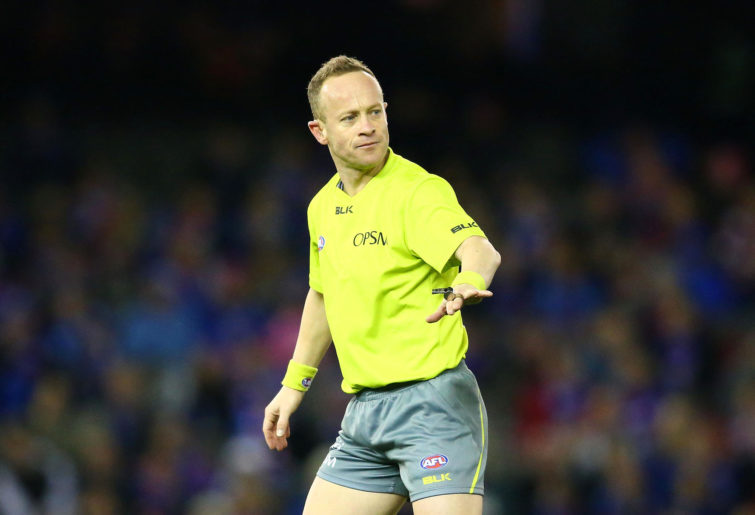The data says Brisbane are a flag contender - but the eye test tells a completely different story
There’s a slight disconnect between the data, the record and the eye test for the Brisbane Lions to start season 2024. This week, Champion…
Opinion
The AFL has a negative issue with congestion. That statement, if accepted as fact, sparks a broad discussion.
Is the resolution via rules regression or rules progression? Hawthorn’s multi-premiership coach Alastair Clarkson has suggested a reversion to 16 a side. The irony is that was a structure of the now almost entirely buried VFA.
Football played at the AFL elite level by the professionals has followed the defence-wins mantra of many other sports globally. Zonal defence has well and truly taken over the way the game is played. Those of my generation grew up with one-on-one defence with accountability for a single opponent. The main variation would be on windy days when an extra player or two might be pushed to the back line in a quarter where limiting the damage was the best strategy.
Australian football from its inception managed to avoid imaginary lines across the field. There’s no offside/onside. However in recent years we’ve seen the protected zone around a player and also now the nine-metre line that is an extension of the top of the goal square. Still though, there’s effectively no restriction on player movement around (up and down) the ground proper.
Once upon a time footy at the top level was played on ovals shared with the local cricket club. The MCG retained a centre wicket square until the late 1990s but since then has been move a football oval than a cricket oval.

(Photo: Julian Smith/AAP)
This has been one of the great facilitators of player movement around the ground. The capacity to rapidly push back into the defensive zone is like it’s never been before in the game. The ground surfaces are too good. This enables the defensive structures, combined with the high rotations off the interchange.
It would be nice if the flip side was that offensive breaks were able to push forward rapidly too. However, all too often there are no targets in place.
In the 1990s North Melbourne coach Denis Pagan used what became known as Pagan’s Paddock. Generally Wayne Carey was commonly isolated one-on-one in the forward half and all other players pushed up high. Was it a flood?
The theory was simple: that a ball then kicked into the largely vacant forward half would result effectively in a foot race with the pressure on the defenders that if they gain possession then they needed to U-turn away from goal.
Pagan still sought to win – he was after about four goals a quarter with the logic that 16 goals would win most games. Not every club had or has a Wayne Carey-type player to employ in such a role. In recent times we’ve seen Richmond isolate Dustin Martin deep forward and Geelong likewise with Patrick Dangerfield. The 1990s produced some great footy.
I’m not a great fan of over-regulation. Would it be appropriate to force one or two players each always in the defensive or forward 50 or in the vacant half of the ground? That perhaps is something too closely resembling offside. I’m no fan of that.
We need to be careful to not over-regulate the game as that may reduce the capacity to employ team-specific strategies. Were we to attempt to manipulate the game via rules to produce a high-scoring, free-flowing game it might unwittingly become just a little too contrived and a little too prefabricated?

(Photo: Scott Barbour/Getty Images)
What I am a fan of is actually adjudicating the rules we have. An example is the chopping of the arms, which I feel is poorly adjudicated and gives defenders too much scope to negate our tall marking forwards. Consequently, most of the time now we don’t see stay-at-home forwards. It’s perhaps too easy to rebound off a single marking tall forward, unless they are super competitive at ground level.
In 2014 the AFL’s Laws of the Game charter laid out the game’s untouchables. Eighteen per side on an oval was part of that. The original league – the VFA – for many years ran a 16-aside format. The VFA has been taken over and rebadged VFL. It would be an irony for the AFL to revert to that format.
However, whatever the number, defensive structures would be prioritised. And given the penchant for last-touch style free kicks, the irony of that too is that it presents less of the ground that needs to be defended because the boundary line on either side behaves as a virtual extra two players.
The key for some is fewer players around a stoppage. The alternate is to have fewer stoppages. This screams that the first free kick should be paid. Prior opportunity seems to have muddied the water.
I’d hate to see some elements of the game that provide distinction to other codes become eroded. No last touch. And try to retain 18 on 18. The risk-reward paradigm could be revisited. In part, following the 3-2-1 scoring system of basketball. I actually like super goals: nine-point goals from outside 50.
Yes, the AFL Charter maintains a six-point goal and one-point behind. That can assist in spreading the defence a little. And create set-play scenarios to get the ball in the hands of the longer kickers.
It’s a level of excitement to entice that long shot at goal that may also drop short into the goal square where many a hanger has been taken. Goal-kicking isn’t easy. It’s not supposed to be.
Is Clarko on the mark with 16 aside? Should there be more or less interchange? Should there be some method of set positions? Should there be some form of offside? Should prior opportunity be revisited?
And was Hawthorn over-feted as the trend setter? After all, had Freo kicked straight…